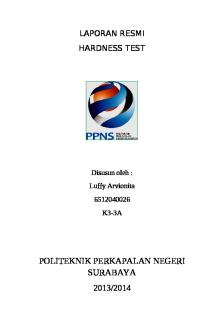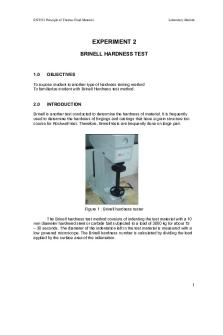EXPERIMENT 3 HARDNESS TEST DOCX

| Title | EXPERIMENT 3 HARDNESS TEST |
|---|---|
| Author | Min YIh |
| Pages | 8 |
| File Size | 59.6 KB |
| File Type | DOCX |
| Total Downloads | 322 |
| Total Views | 441 |
Summary
EXPERIMENT 3: HARDNESS TEST OBJECTIVE The objective of this experiment is to determine the hardness of a material by using a hardness tester. INTRODUCTION One of the mechanical properties that may be important to consider is hardness, which is a measure of a material’s resistance to localized plasti...
Description
EXPERIMENT 3: HARDNESS TEST OBJECTIVE The objective of this experiment is to determine the hardness of a material by using a hardness tester. INTRODUCTION One of the mechanical properties that may be important to consider is hardness, which is a measure of a material's resistance to localized plastic deformation (e.g., a small dent or a scratch) or in other words, it is a measure of the resistance of a metal to permanent (plastic) deformation. Early hardness tests were based on natural minerals with a scale constructed solely on the ability of one material to scratch another that was softer. A qualitative and somewhat arbitrary hardness indexing scheme was devised, termed the Mohs scale, which ranged from 1 on the soft end for talc to 10 for diamond. Quantitative hardness techniques have been developed over the years in which a small indenter is forced into the surface of a material to be tested, under controlled conditions of load and rate of application. The depth or size of the resulting indentation is measured, which in turn is related to a hardness number; the softer the material, the larger and deeper the indentation, and the lower the hardness index number. The indenter, which is usually a ball, pyramid, or cone, is usually made of hardened steel, tungsten carbide, or diamond, a much harder material than the material being tested. 1...
Similar Free PDFs

EXPERIMENT 3 HARDNESS TEST
- 8 Pages

laporan uji bahan hardness test
- 8 Pages

Lab 1 - Brinell Hardness Test
- 15 Pages

Brinell Hardness Test Lab #1
- 6 Pages

E2- Brinell Hardness TEST
- 5 Pages

Experiment 3
- 6 Pages

Experiment 3
- 8 Pages

Vickers Hardness Testing
- 9 Pages

Torsion Test Experiment 2
- 5 Pages

Experiment 3- Nomenclature
- 7 Pages

Experiment 3 Final Piece
- 4 Pages
Popular Institutions
- Tinajero National High School - Annex
- Politeknik Caltex Riau
- Yokohama City University
- SGT University
- University of Al-Qadisiyah
- Divine Word College of Vigan
- Techniek College Rotterdam
- Universidade de Santiago
- Universiti Teknologi MARA Cawangan Johor Kampus Pasir Gudang
- Poltekkes Kemenkes Yogyakarta
- Baguio City National High School
- Colegio san marcos
- preparatoria uno
- Centro de Bachillerato Tecnológico Industrial y de Servicios No. 107
- Dalian Maritime University
- Quang Trung Secondary School
- Colegio Tecnológico en Informática
- Corporación Regional de Educación Superior
- Grupo CEDVA
- Dar Al Uloom University
- Centro de Estudios Preuniversitarios de la Universidad Nacional de Ingeniería
- 上智大学
- Aakash International School, Nuna Majara
- San Felipe Neri Catholic School
- Kang Chiao International School - New Taipei City
- Misamis Occidental National High School
- Institución Educativa Escuela Normal Juan Ladrilleros
- Kolehiyo ng Pantukan
- Batanes State College
- Instituto Continental
- Sekolah Menengah Kejuruan Kesehatan Kaltara (Tarakan)
- Colegio de La Inmaculada Concepcion - Cebu




